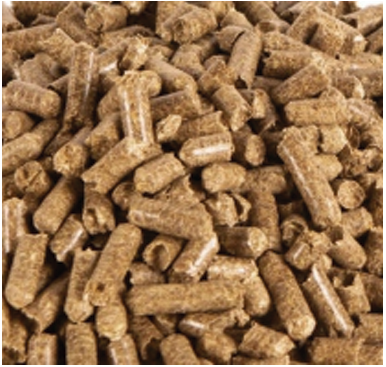Biomass Pellets & Animal Cattle Feed Pellets
About Product


About Product
Our biomass pellets are meticulously crafted using renewable resources, providing efficient and clean energy for
various applications. Additionally, our cattle feed pellets are formulated to meet the nutritional needs of livestock,
ensuring optimal health and performance
Types of pellets manufacture in plant :
Pure Napier grass pellets
Agricultural waste pellets
Pine wood pellets



PELLETS USED SECTOR
Furnace Industry:
Biomass pellets can be used as a renewable fuel source in furnaces for heat generation, particularly in industries such as metallurgy, ceramics, and glass manufacturing.
Boiler Industry:
Biomass pellets are commonly used as a sustainable alternative to fossil fuels in boilers for steam generation, which is crucial for processes in industries like food processing, textiles, and pulp and paper.
Steel Plants:
Biomass pellets can serve as a carbon-neutral fuel source in steel production processes, reducing reliance on coal and lowering carbon emissions in the steelmaking industry.
Pharmaceutical Industry:
Biomass pellets can be utilized in pharmaceutical manufacturing facilities for steam generation and heating purposes, supporting various production processes while adhering to sustainability goals.
Hotel Industry:
Hotels can use biomass pellets for heating, hot water generation, and cooking, reducing their carbon footprint and promoting eco-friendly practices in the hospitality sector.
Chemical Industry:
Biomass pellets can be integrated into chemical production processes for heat and energy, contributing to the sector’s efforts to transition to more sustainable and environmentally friendly practices.
Electricity Generation:
Biomass pellets are used in biomass power plants to generate electricity, providing a renewable energy source that complements traditional fossil fuel-based power generation.
Catering Industry:
Biomass pellets can be used in commercial kitchens and catering facilities for cooking and heating, offering a sustainable alternative to conventional fuels like LPG or electricity.
Cement Industry:
Biomass pellets can be co-fired with coal in cement kilns to reduce greenhouse gas emissions and energy costs while maintaining high temperatures necessary for the cement manufacturing process.
Paper Industry:
Biomass pellets can serve as a renewable energy source for paper mills, providing steam and heat for various papermaking processes and contributing to the industry’s sustainability objectives.
BENEFITS
Pollution-free: Biomass pellets, when burned efficiently, produce significantly lower emissions compared to traditional fuels like coal or wood.
This helps in reducing air pollution and mitigating the impact on public health and the environment.
Save India: By utilizing biomass pellets as a renewable energy source, India can reduce its dependence on imported fossil fuels, thus promoting
energy security and sovereignty.
Farmer Income: Biomass pellet production can create additional income streams for farmers by providing them with opportunities to sell
agricultural residues and other biomass feedstocks. This can contribute to rural development and poverty alleviation.
Economy Growth: The biomass pellet industry can stimulate economic growth by creating jobs in production, distribution, and maintenance
of biomass pellet systems. Additionally, it can attract investment in related infrastructure and technologies.
Low Ash Content: Biomass pellets typically have low ash content, which means they produce less residue when burned. This makes them
more efficient and easier to clean compared to traditional fuels.
Easy Storage: Biomass pellets have a high energy density and are compact, making them easy to store and transport. This ensures a consistent
and reliable fuel supply for various applications.
Risk-Free Storage: Unlike some other forms of biomass, such as loose agricultural residues, pellets are less prone to spoilage and degradation
during storage. This reduces the risk of losses for both producers and consumers.
Economical: Biomass pellets can be produced at a relatively low cost, especially when using locally available feedstocks. This makes
them a cost-effective alternative to fossil fuels, especially in regions with abundant biomass resources.
Biomass Pellets
Basic Biomass Pelleting Process
RAW MATERIAL: Pure Napier Grass, Agricultural Waste, And Pine Wood.
SHERADING : The first step is to shred the raw materials into smaller pieces. This can be done using various shredding
equipment depending on the material’s characteristics and the desired size of the particles.
SEPARATION : After shredding, the material may need to undergo a separation process to remove any impurities or unwanted components. This could involve using screens, air classifiers, or other separation techniques.
DRYING : The shredded material typically contains moisture, which needs to be reduced to achieve the desired moisture content for pelletization. Drying can be done using methods such as rotary dryers, fluidized bed dryers, or belt dryers.
MIXING : Once dried, the material may undergo mixing to ensure uniformity and consistency in the pellet composition. This step may involve blending different types of raw materials or adding binders or additives to improve pellet quality.
CONDITIONING : Conditioning the material involves further adjusting its moisture content and temperature to optimize pellet formation during the pelleting process. This step is crucial for achieving pellets with the desired density and durability.
PELLETING : The conditioned material is then fed into a pellet mill or pelletizer, where it undergoes compression and extrusion through a die to form dense pellets of uniform size and shape. The die can be customized to produce pellets of different diameters and lengths.
COOLING : After pelletization, the hot pellets need to be cooled to room temperature to stabilize their structure and prevent them from deforming. Cooling can be achieved using a counterflow cooler or other cooling systems.
PACKING : Once cooled, the pellets are ready for packaging. They can be packed in bags, bulk containers, or other
packaging formats depending on the intended use and market requirements.
RAW MATERIAL BIOMASS/ENERGY FARMING : NAPIER GRASS FARMING
Empowerment of farmers and Rural Economic Impact can be achieved with systematically grown biomass by farmers also known as ‘Energy Farming’. It primarily includes Napier Grass but can also include other crops like bamboo, algae or any other crops biomass as per local agroclimatic conditions. While Agri residue can also be used, these crops will generate a good amount of income for farmers. Since the biomass would be required in huge quantity, significant economic change is possible in Rural India.
CARBON SEQUESTRATION BY NAPIER GRASS
Nappier grass besides absorbing emissions from COAL, in addition actually clears the air of co2 which is present already in the atmosphere and responsible for global warming. This process is known as carbon capture or carbon sequestration. It captures co2 and puts it in the soil, which increases the fertility of the soil.
Napier grass, raw material for COAL, plays a crucial & most beneficial role in clearing accumulated CO2 from the atmosphere, which is known as ‘carbon capture’ or ‘carbon sequestration’ co sequestration is the most potent way to offset global warming Napier grass captures min 1 Ton/Hect 1 year from 2nd year onward & for the next 20 years

